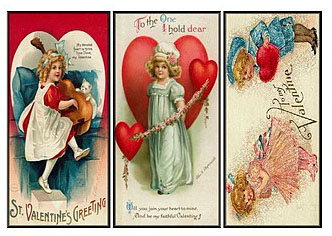
ANSWER: Bookmarks have been around in some form or another for hundreds of years, ever since the first printed book rolled off the press in 1455. What a lot of people don’t know was that bookmarks were popular gifts, especially during Victorian times. And many people gave them as small Valentine gifts.
Over the years, Valentine gifts have taken many forms—cards, chocolates, even bookmarks. But whatever form they have taken, these expressions of love often displayed a heart of some sort.
People often gave bookmarks as gifts and as souvenirs or to commemorate a number of events. The heart shape in bookmarks often served to convey expressions of emotions, religious sentiments, or as a way to advertise products of the day.
Also called bookmarkers, these were important instruments for people to use to keep their place while reading. Surprisingly, a great many bookmarks are in the shape of a heart or contain some kind of heart motif.

Bookmarks became more common by the post Industrial Revolution. By the mid-19th century there was a convergence of improved methods in the book binding process and an overall increase in literacy. With improved book printing techniques, books became less expensive to produce, and more available to a lot of people. But no one usually read an entire book in one sitting, so bookmarks became a necessary way to mark the place where the reader stopped.

Between 1850 and 1900, home-crafted bookmarks of needlework on perforated cards became quite common. Printing techniques dramatically changed from 1860 through 1900 and ushered in the “Era of Lithography." Names such as Currier & Ives and Prang were to the best known associated with lithography and chromolithography.

Because the shape of the heart has long been a symbol of love, affection, deeply felt sentiments, caring, concern and earnestness, its easy to see why makers of bookmarks often turned to the heart as a theme.
The intertwined cross, anchor and heart were often meant to represent faith, hope and charity. Was this bookmark a symbolic religious expression of late Victorian or turn of the century sentiments? Or was this possibly the bookmark of a tea captain? Or was it designed to be given by a sailor to his sweetheart or wife as a gift, a gift that would remind the recipient of the giver whenever a book was read?

Embossed aluminum bookmarkers fashioned in the shape of hearts were quite popular during the 20th century, especially for souvenirs. A 1901 heart bookmark with embossing read "Pan American Exposition, 1901, Souvenir" around the raised raging bull symbol. Another example features an embossed aluminum bookmark that bears + the Bunker Hill Monument.
To read more articles on antiques, please visit the Antiques Articles section of my Web site. And to stay up to the minute on antiques and collectibles, please join the over 30,000 readers by following my free online magazine, #TheAntiquesAlmanac. Learn more about the "Antiques of Christmas" in the 2021 Holiday Edition, online now. And to read daily posts about unique objects from the past and their histories, like the #Antiques and More Collection on Facebook.


